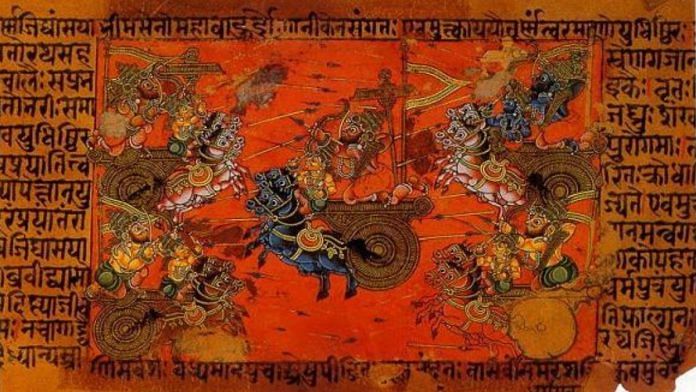Jai: You know, one question has always bothered me about the Gita. Is its battlefield setting metaphorical? How can it be literal? Is the Gita a book calling for violence?
Harsh: Important question. And it’s related to our theme of learning from life. The Gita is essentially a book of neither violence nor silence, but of transcendence. It uses the battlefield setting to demonstrate dramatically that its call for transcendence is practical, responsible, and dynamic.
Jai: Go ahead.
Harsh: Many people feel that spiritual knowledge is too otherworldly and so is impractical or irrelevant given the urgent practical demands of this world. Leaders especially are often under much more pressure than others. To address such concerns, the Bhagavad-gita’s spiritual message is delivered in a setting that is eminently this-worldly and calls for the most urgent practical action. By showing how its spiritual wisdom solaced and empowered a responsible head of state, the Gita poignantly illustrates the universal applicability of its teachings. If a person on a battlefield spared time for gaining its spiritual wisdom and found it relevant, practical, and empowering, then no one needs to doubt the practicality of the Gita’s message and no circumstance needs to warrant relegating that message to the “to be done later” category.
Investing time in Gita wisdom protects leaders from staying stuck as managers. Managers ensure that things are done right; leaders ensure that the right things are done. Managers check if the team climbs up the ladder properly; leaders check if the ladder is leaning against the right wall. The Gita expands the vision of leaders and helps them see the big picture, thereby protecting them from the pitfall of getting caught up in the immediate at the cost of the ultimate.
Also read: Bhagavad Gita wasn’t always India’s defining book. Another text was far more popular globally
Socially responsible spirituality
Jai: You may say that the Gita is practical, but isn’t it too otherworldly? Doesn’t its spiritual message make people just renounce the world or become apathetic to it?
Harsh: No, the answer can be seen in the effect of Gita wisdom on its original student – a leader inclined toward renouncing responsibility re-embraced responsibility.
Jai: But why would a spiritualist return to worldly affairs such as ruling a kingdom?
Harsh: Because the Gita is concerned with establishing dharma, a sociopolitical order that fosters moral and spiritual integrity.
When the ruling heads of state are morally and spiritually depraved, as they were before the Kurukshetra war, assertive action is essential to prevent people from being exploited. The Mahabharata sections preceding the narration of the Gita describe vividly:
- The multiple injustices and atrocities committed by the ruling heads of state, the Kauravas,
- The repeated efforts of the victims, the Pandavas, to restore justice and morality peacefully,
- The utter disdain with which the Kauravas dismissed all attempts at reconciliation, thus making a peaceful solution impossible.
For those victimized by blatant injustice, a passive spectator role reduces noble pacifism to impotent and suicidal utopianism. No wonder the Gita advocates pragmatic assertive action for protecting basic human rights.
Jai: Yes, you know one of my favorite quotes is the one attributed to British statesman Edmund Burke, “The only thing needed for the triumph of evil is that good people do nothing.” Nice to see the Gita echoing that theme.
Harsh: Yes, and the setting stresses that violence should be the last expression of such assertiveness – and never anything other than the last. This is illustrated by the exhaustive peace efforts that preceded the Gita. The very fact that globally acclaimed champions of non-violence such as Mahatma Gandhi found inspiration in the Gita’s message demonstrates that violence is not its core message.
 This excerpt from ‘Gita for the CEO’ by Chaitanya Charan Das has been published with permission from HarperCollins.
This excerpt from ‘Gita for the CEO’ by Chaitanya Charan Das has been published with permission from HarperCollins.







Is Russia following dharma in invading ukraine? If ukraine is the victim of injustice here, why is India still supporting Russia? Maybe applying Gita to real world scenarios would help.
ISKCON and it’s bunch of clowns should learn to keep to themselves. Cults like these have no place at all in modern human society.
ISKCON is just Islamized Hinduism. When Hinduism is contorted and distorted to fit the Abrahamic mould – one gets ISKCON.